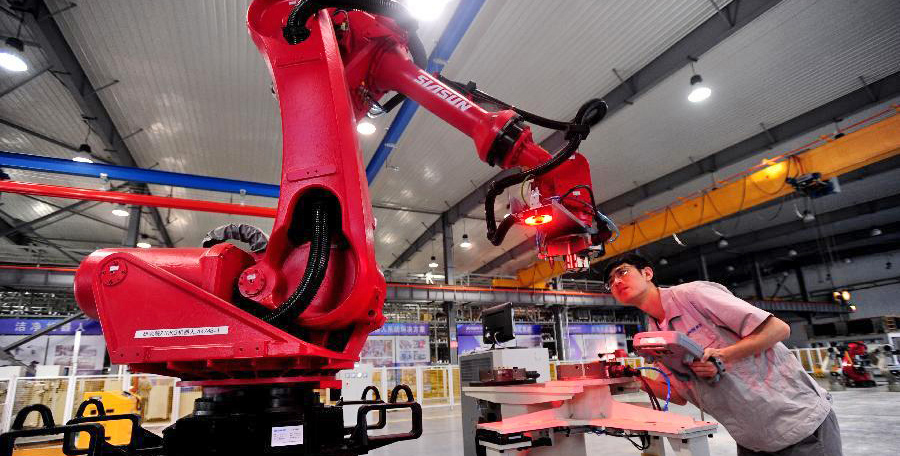State Council unveils blueprint to upgrade ‘Made in China’

A worker is checking a robot that is to be used in manufacturing. Intelligent manufacturing is leading reforms in the industry.
The State Council recently released its Made in China 2025 plan that outlined the country’s strategy to go from a “big” to “strong” manufacturing country. The plan predicts the major direction for development of China’s manufacturing industry in the coming decade.
Major industrialized countries are attaching greater importance to the manufacturing industry. The US, Germany and Japan all have plans to boost manufacturing to improve their economic competitiveness.
Rui Mingjie, a professor from the School of Management at Fudan University, said that the shift from “deindustrialization” to “reindustrialization” in developed Western countries marks a reorientation in the economy based on the future development of manufacturing.
Huang Yanghua, an associate research fellow from the Institute of Industrial Economics at the Chinese Academy of Social Sciences, said Western countries have realized the importance of real economy to economic growth and stability in the wake of the global financial crisis in 2008.
“The US made the profoundest introspection. It re-evaluated the role and function of its manufacturing industry, finding that economic growth wouldn’t be sustainable if it solely concentrated on research and development, design, branding, marketing and other high-end links in the value chain, after it outsourced manufacturing to low-cost countries,” Huang said.
Opportunities for upgrading
Huang added that the transformation and upgrading of the manufacturing industry had entered a “crucial stage,” noting how many enterprises are seeking new investment opportunities despite concerns over high costs and upgrading risks.
Rui said that developing countries should take advantage of opportunities for economic acceleration. China’s broad market provides conditions for structural transformation and upgrading, Rui added.
However, scholars also identified problems that will pose challenges to the transformation process, including weak innovative capacity, unsatisfactory quality and insufficient brand credibility as identified by Song Shilei, a research fellow from the Institute of Quality Development Strategy at Wuhan University.
Huang said Made in China 2025 is a strategic plan with broader scope than five-year plans and short-term blueprints. It aims to enhance the confidence of manufacturing enterprises by guiding them to attainable goals.
Avenues for breakthroughs
When asked how China’s manufacturing industry can make breakthroughs, Huang said close attention should be paid to new production factors. For example, as information technology is now increasingly infused into the development of manufacturing technology, data will become an essential new production factor and competitive advantage.
Rui proposed two measures for improvement. The first is to further advance reforms and offer policy support for technological transitions among private enterprises. The second is to optimize the financial service system, attracting international experts and training talents in China who are proficient in both manufacturing and the Internet.
Huang emphasized the importance of creating an environment friendly to real-economy development, noting the notion of a “strong” manufacturing country inherently embodies the key role of the manufacturing industry upgrading as the economy grows. Goals should therefore be based on the nation’s economic and social development as well as improving people’s living standards.
To this end, Song gave three suggestions. First, the government should play a guiding role while being careful not to wield excessive control. Second, it should foster a market with fair and free competition, build a market operating mechanism contributing to fair price and high quality, and avoid the vicious cycle of “bad money driving out good money.” Third, different levels of manufacturing should be balanced to ensure each product is of high quality, even if not all products are high-end goods.
Zhang Jie is a reporter at the Chinese Social Sciences Today.

 PRINT
PRINT CLOSE
CLOSE